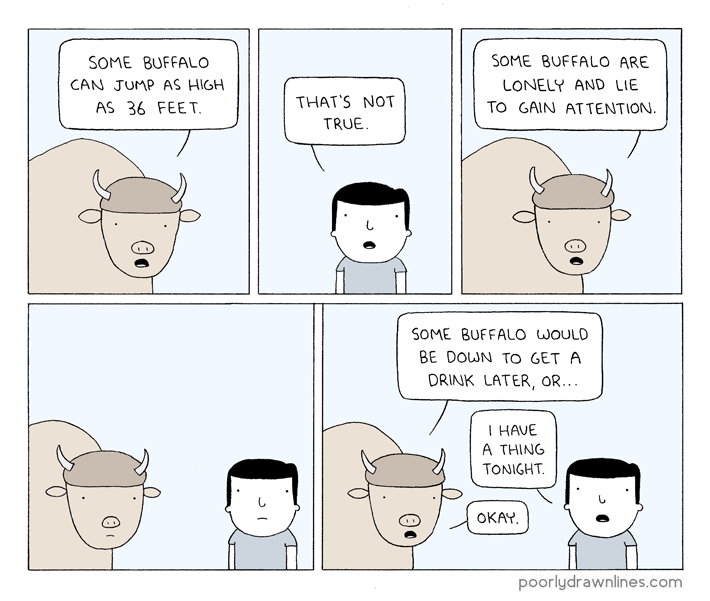¡Esto es lo que yo estaba esperando! ¡No puedo creer que exista gente como ellos! (Alan Vega, a la salida de un concierto de Ramones en el CBGB, 1974).
¡Es esto!, ¡Es esto! (Chris Frantz [Talking Heads], exultante en el CBGB, 74).
¡Me declaro su primera fan! (Debbie Harry [Blondie], mismo sitio y año).
(Yo no te hubiera conocido si no llega a ser por) los Ramones. (Pistones, Madrid, 1982).
En 1974, Arturo Vega, un artista mexicano afincado en Nueva York, se hizo con un stock desechado de camisetas. Había estado fabricando abalorios para los New York Dolls, una catastrófica y fascinante formación de imitadores glam de los Rolling Stones, y ahora se preguntaba qué podría hacer con tanta tela. Sus nuevos compañeros de piso, Joey y Dee Dee, también tenían un grupo que estaba siendo la sensación de la ciudad, con sus primeros conciertos en un tugurio llamado CBGB, donde antes de ellos y un grupo de rock de arte y ensayo, Television, no quería tocar nadie, porque allí solo se hacían lecturas de poesía beatniks y actuaban artistas country. Arturo, entusiasmado con la imagen y el sonido del cuarteto, empezó a decorar camisetas para sus amigos.
Los testigos de estas actuaciones afirman que durante los apenas veinte minutos que duraban, se tenían que agarrar al mobiliario igual que si estuviesen en una montaña rusa, de la onda expansiva que salía del escenario. El grupo, con evidentes limitaciones técnicas, tocaba a una velocidad endiablada. El sonido era una vorágine en la que se encadenaban temas de un minuto y medio, o dos como mucho. Jon Savage los describe en su libro, «canciones tan breves que reflejaban la fragmentada capacidad de concentración de la primera generación de televidentes» (1).
Joey se había pedido ser el batería, pero Tommy, un talentoso ingeniero de sonido que oficia estos primeros años de manager y cerebro del grupo, ha recomendado que sea el cantante, mientras él se queda con los tambores, aunque nunca los haya tocado. La razón es obvia: Joey llama la atención por donde va, ya que aparte de medir dos metros de altura, es un tipo muy especial y su voz es realmente característica, producto de una sinusitis crónica. Joey ha comenzado a variar su imagen de artista glam por una versión más rockera, y de su antiguo look con camisas de raso, guantes y botas de plataforma fucsia, solo conserva el pelo largo y las gafas de miope con cristales de color rojo oscuro. Arturo adora a Joey, como lo vamos a adorar varias generaciones de headbangers, y le ha regalado una camiseta con el logo de la marca de pegamento Carbona.
En 1975, a Dee Dee, el bajista, le serigrafía una camiseta con la foto del príncipe Carlos para llevar la contraria a los Sex Pistols. Si esos ingleses tan arrogantes eran antimonárquicos, ellos serían pro familia real. Dee Dee iba a ser el cantante, pero ha desistido pronto, porque bastante tiene con aprender a tocar un Danelectro que destrozará en pocos meses. Lleva el mismo pelo de Bruce Lee y es toda una personalidad, como la estrella de cine, pero en versión buscavidas de Queens. Tiene auténtico talento para escribir canciones y meterse en líos, trapicheos de drogas y peleas de las que conserva algunas cicatrices. Ha tenido los empleos más dispares, hasta el de peluquero. A veces le corta el pelo a Johnny, el guitarrista, un tipo serio y calmado que luce una cuidadísima melena, muy parecida a la de Keith Relf de los Yardbirds. Esa melena y su primera guitarra Mosrite de cincuenta pavos (como las que tocaban los Ventures) pasarán a la historia. Bueeno, los estilismos capilares de Fred y Dennis de los MC5 también han influido en los peinados de Joey y Johnny.
Estaban en Washington haciéndose fotos, y Arturo se fijó en las banderas y los emblemas, omnipresentes por toda la ciudad. Recordó la obsesión de Dee Dee por la parafernalia nazi —uniformes, soldaditos, esvásticas— de cuando vivió de niño en una base en Alemania por su padre, teniente del ejército, así como la problemática educación de Johnny, que terminó a trompicones la secundaria en un par de academias militares.
Lo vio claro. El sello del presidente, con el águila imperial agarrando las ramas y las flechas, era perfecto para ellos.
Pero había que realizar algunos cambios: «En lugar de la rama de olivo, dibujé una rama de manzano, ya que ellos son tan americanos como el pastel de manzana. Y como Johnny era un fanático del béisbol, puse al águila sosteniendo un bate». Con el nombre del grupo en grandes letras mayúsculas, alrededor del sello estampó los del cuarteto: Johnny – Joey – Dee Dee – Tommy. El lema que sostiene el águila en su pico ya no era «E pluribus unum». Es el lema que medio mundo lleva encima y posiblemente, ahora tiene la misma idea sobre su significado que como si fuera el otro en latín: «Hey Ho, Let´s Go». (2)

Este es el origen del logo de los Ramones y su camiseta, prenda que ha sobrepasado la música y los hechos de uno de los grupos más emocionantes de la historia del pop. Nunca un logo ha sido tan descontextualizado, tan vaciado de su intención primaria para convertirse en un simple adorno, sin más mensaje que el atractivo del dibujo y el curioso nombre. Este fenómeno es común a otras muchas camisetas que han usado y usan millones de fans para celebrar su devoción por su artista favorito. La de Nirvana, que tiene unas letras muy parecidas, y no por casualidad, va por ese camino, así como las de Guns´n´Roses y otras bandas conocidas. Todas se pueden encontrar en la zona joven de unos grandes almacenes, lugar donde no hace mucho tiempo hubiese sido imposible imaginar uno solo de estos objetos. Pero por encima del resto de prendas tristemente desprovistas de su sentido y su sensibilidad, hemos visto a media humanidad vestida con la camiseta de los Ramones, desde famosos de segunda en Hollywood a personajes de tercera en España. Y el pueblo llano. Lo mismo la luce un candidato a «Granjero busca esposa» que un coolhunter, el vecino o la señora del súper. Se ha fabricado en todos los materiales posibles, la tela en colores flúor, en formato vestido, para bebés y hasta para mascotas… Incluso otros grupos la han remodelado para anunciar su propio nombre, por no hablar de la cantidad de bares y asociaciones que la han usado, con interpretaciones más o menos afortunadas. Ha vendido millones de copias, primero en las tiendas de memorabilia rock, pero ahora lo mismo la ves colgada en los mercadillos de frutas e imitaciones de perfumes que en franquicias de ropa. Dio a su creador, Arturo Vega, que falleció el año pasado, fan acérrimo y amigo leal, royalties para vivir cómodamente hasta entonces. Los discos de los Ramones, evidentemente, no han tenido ni una cuarta parte de ese éxito comercial.
Los fundamentalistas se enfadan porque a los Ramones los lleven en su pecho gente que jamás los ha escuchado ni lo hará nunca; es más, que si lo hiciera, se horrorizaría. La mayoría no sabe lo que significa ese dibujo, si se trata de una agrupación política o una peña de amigos (4). Se enfurece el fan cuando lee en los suplementos de moda articulines sobre la camiseta o ve a un famoso de esos de la tele ataviado con la prenda en una tertulia del corazón. Pero esta confusión sigue siendo igual de divertida y estúpida como cuando el movimiento punk lucía en bloque la camiseta. Un símbolo que tiene un aspecto, reconozcámoslo, marcial, genuinamente americano y no muy airado, poco que ver con los lemas que el avispado modisto Malcolm McLaren hacía lucir a sus criaturas para vender ropa, tipo la camiseta con la cruz invertida y la palabra «Destruye» de su tienda. Sí, imprimirse el sello del presidente de los Estados Unidos con unas modificaciones pop era muy típico de la época y los de Ramones, burlones hasta el final, pero ellos también se ponían otras camisetas en las que se podía leer «Let God Kill´em All», un lema utilizado por los boinas verdes, que podía ser una ironía en el caso de Joey, mucho más distanciado que sus compañeros con las instituciones (como hicieron cientos de artistas de su generación, los primeros en enfrentarse a hechos de la historia reciente desde posturas ambiguas, humorísticas o esteticistas), pero también una declaración de principios de Dee Dee, como en su fabuloso «53rd & 3rd», tragicomedia al estilo Taxi Driver. Junto al nihilismo que compartían con la nueva música, había en ellos otros mensajes que muchos no han querido asimilar, como cuando Johnny declaró, ya de mayor y con el grupo disuelto, su adhesión al partido republicano y la gente se rasgó las vestiduras, como si antes nadie lo hubiese sospechado. (3)
Ahora igual. Provoca bochorno al tiempo que carcajada leer en las webs de moda el apartado «T-shirts de música» (las de AC/DC y Iron Maiden también son un clásico de la descontextualización), como outfit para combinar en un evento (no estoy segura de lo que significan estas palabras). En una de ellas, por ejemplo, y no hace ni un par de meses, leo a una bloguerette que dice que le encanta su T-shirt de los Ramones, pero que no iría jamás a un concierto suyo, salvo «superbien acompañada», supongo que de un criado fornido para una sesión de ultratumba. Con casi todos los Ramones muertos, y todavía hay gente que se asusta de artistas que se vestían de delincuente juvenil hace cuarenta años.
A mitad de los años setenta aún era raro ver en los conciertos un puesto con camisetas, sobre todo si el grupo no era Kiss. Pero cuando explota el punk, la camiseta estampada con la foto de un grupo o un lema (muchas veces, escrito a rotulador o boli) adquiere una dimensión tan importante como la propia música. Era un gesto social que te señalaba afecto a unas ideas, demostraba tu malestar y tu gusto. Tenías algo que los demás no compartían y además les desagradaba. Llevabas puesta una (anti)estética, la ropa envolvía y señalaba la idea, tu situación contra el mundo. Los actuales libre-defensores del consumo de camisetas malas de los Ramones, solo porque es genial que ya nadie sepa qué encierran los mensajes que una vez alguien creó con una intención, ya que se ha generado la demanda y eso es lo más sagrado, están defendiendo una ideología muchísimo más agresiva y oscura que la que exhibe el que se pega un demonio en la cazadora, porque le gusta a rabiar el heavy metal, y también, por supuesto, porque combina con su peinado y los pantalones.
En mi seguro que distorsionada percepción de la realidad, creo que se empieza por no tener ni idea de qué va el muñeco que llevas de adorno en el outfit ese, y terminas votando en las elecciones con el mando de la tele, como si mandaras un mensaje para ganar un viaje a Torrevieja. (Sí, creo que necesito psicoterapia. Incluso un tratamiento de shock).
Los Ramones pasaban el rato en la Heladería Jahn en verano y en invierno en las escaleras de los pisos. Para divertirse, iban a los almacenes Alexander´s a ver cómo compraba la gente. (Richard Hell).
Los Ramones no eran revolucionarios de salón. No leían ensayos europeos de tipos que, tras vagar borrachos por la calle, luego se inventaban no sé qué rollo de ir a la deriva. Simplemente invocaban algo que llegaba de forma instantánea a cuantos los escuchaban: el aburrimiento de la adolescencia en la segunda mitad del s. XX, el que te llevaba a dar vueltas por la calle sin saber qué hacer, estar tirado en un sofá viendo la tele, escuchando la radio o leyendo cómics. El sentimiento de ser un rechazado, porque las chicas no te hacían caso y los demás pensaban que eras un idiota a causa de tus pintas y tu comportamiento. Por eso, porque eras raro, había que llevar la contraria, porque esa es la actitud cuando no tienes expectativas y no entiendes nada en un mundo que está, como tú, desquiciado. Ellos compartían una visión inteligente y caótica sobre la realidad, por eso mezclaban las imágenes de la película mondo La locura americana con las de Patti Hearst cuando posaba como una estrella delante de la pancarta del Ejército Simbiótico de Liberación. Patti y las monjas karatecas resultaban igual de absurdas y risibles. La Familia Manson se hilaba con un show de los Ice Capades, y la máquina de soda del Burguer King con el Ku Klux Klan; un universo pop plagado de contradicciones, violencia, locura e infantilismo.
Los Ramones no eran cuatro cretinos sin luces que habían reducido los tres acordes del rock a uno y medio y lo acompañaban de letras que nadie con dedos de frente hubiese escrito. Esa definición se puede aplicar a la mayoría de sus irritantes explotaciones, cientos y cientos de grupos por el mundo, pero no a ellos. Desde 1974 a 1976, fecha de publicación de su primer disco, fueron demoliendo —deconstruyendo, creo que dicen los empollones— sabia y cuidadosamente, como aparentando que no tenían ni idea de nada, la herencia del pop desde los años cincuenta, el beat, el sonido Phil Spector, las baladas melodramáticas de las Shangri-Las y las canciones que salían del edificio Brill, la música high school, el glam, el surf, la psicodelia, el garaje, e incluso manifestaciones de rock adulto como Lou Reed, los Stooges y algunos dinosaurios del hard rock, hasta reducirlo todo a su mínima expresión, temas de menos de tres minutos en un aparente caos de velocidad, ruido y coros sixties, con historias protagonizadas por personajes salidos de La matanza de Texas y de Marvel, detallando la frustración y la rabia de los chicos y las chicas, la insoportable cotidianeidad de la clase media de Forest Hills, donde no nunca pasa nada, pero, a veces, en el sótano puede vivir una encantadora pareja de pinheads.
Hay incontables trazas de la herencia de los Ramones, por desgracia no reconocidas en la mayoría de los casos, a veces por maliciosa omisión y otras por puro desconocimiento. Y lo peor de todo, reducidas en la actualidad a un mal chiste: la imagen, elaborada por ellos mismos contra el look de los hippies (chupas de cuero, pantalones rotos a propósito, zapatillas Keds, camisetas dos tallas más pequeñas, melenas y flequillos pop…), su actitud sin igual en el escenario, la forma esquemática de presentarse ante el público, descolgar guitarra y bajo hasta la rodillas en obstinada declaración de antivirtuosismo, y, por supuesto, las canciones… elementos de un pasado remoto, donde solo permanece una camiseta que nadie sabe qué significa, en un mundo manejado por cretinos, pero ahora de los de verdad. Tommy Ramone decía que no a todos los grupos aficionados les sale un primer elepé como el de los Ramones. Las copias de las copias de las copias son como las camisetas que se estropean a los dos lavados.
_______________________________________________________________________________
(1) Savage, Jon: England´s Dreaming. Los Sex Pistols y el punk rock. Barcelona, Reservoir Books, pág. 133.
Todas las citas sobre los Ramones son de la biografía escrita por Jim Bessman en 1993, The Ramones: An American Band (Ed. Griffin). También son muy recomendables De gira con los Ramones, escrito por Frank Meyer y Monte Melnick, su tour manager (Ed. Munster, 2009), y Hey Ho, Let’s Go: Story of The Ramones (True Everett, Omnibus Press, 2005), así como los documentales Ramones Raw (BMG, 2004) e It´s Alive 1974-1996 (Rhino, 2007).
* En 1996, Galactus y yo, editores de Mondo Brutto, escribimos un libro sobre los Ramones titulado así, 20 años de cretinismo ilustrado que nunca llegó a ver la luz por razones desconocidas. Auto homenaje, por tanto, en la cabecera del artículo. Y en su espíritu.
(2) El lema y el sello han cambiado. Pintado a todo color, rezaba «Look out below» (frase de Spiderman), y la ramita tenía unas manzanas rojas que luego se pintaron en dorado. El nombre de Tommy fue sustituido por el del nuevo batería, Marky, y también hay una camiseta, rara, con la del breve Richie «Beau» Ramone, sustituto en una mala época de Marky. Poco después, Dee Dee, en un pronto descomunal, dejó paso a C. Jay para comenzar su inexplicable carrera de rapero. El fan sabe qué camiseta es la buena según los nombres que aparecen, si la auténtica con Tommy o la del final con C. Jay. El que nunca llegaría a aparecer en las camisetas es el batería de Blondie, Clem Burke, que tocó varias veces con ellos cuando Richie dejó el grupo y a punto estuvo de convertirse en Elvis Ramone.
(3) Son célebres las broncas entre Ramones, que terminaron por no dirigirse la palabra, pero especialmente sus peleas por cuestiones de ideología. Johnny y Dee Dee, adscritos a un pensamiento que tacharíamos de muy conservador: el primero, por convicción; el otro sospechamos los fans que por chifladura, y Joey en una posición de militante de izquierda, a la americana, eso sí. Los pilares del grupo eran personajes maravillosos en la ficción. Como personas, nunca, nunca quieras conocer a tus ídolos.
(4) Llamarse «Ramones» podría haber sido un homenaje anticipado al enorme éxito que tendrían sus conciertos en países como España, México y Argentina, donde los fans los idolatraban, pero no, es un guiño a los Beatles. Paul McCartney firmaba como Paul Ramone para pasar inadvertido en los hoteles. Apellidarse con el mismo seudónimo es un gesto de estilo incomprensible cuando los músicos se tomaban demasiado en serio y tiene más que ver con telecomedias como los Munsters y grupos como los Bay City Rollers, también reivindicados por los Sex Pistols.
Artículos relacionados
-
 Nick Drake, caminando sobre aire sólido
Nick Drake, caminando sobre aire sólido
-
 El mejor guitarrista del que nunca has oído hablar
El mejor guitarrista del que nunca has oído hablar
-
 La historia de Iggy Pop en cincuenta canciones (y II)
La historia de Iggy Pop en cincuenta canciones (y II)
-
 De por qué Todd Rundgren es (también) el epítome musical de los setenta
De por qué Todd Rundgren es (también) el epítome musical de los setenta
-
 Kurt Cobain: El anti-grunge
Kurt Cobain: El anti-grunge
-
 La historia de The Who en 50 canciones (2ª parte: 1970-2013)
La historia de The Who en 50 canciones (2ª parte: 1970-2013)



























































































